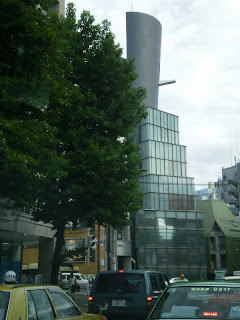
Last weekend I had the pleasure of accompanying a group of 9th graders on a bike trip on the coast of Chiba Prefecture. Along for the proverbial ride,the threes moms bailed on the cycling because our grown-up kids needed all of the adult-sized bikes. But the day was absolutely glorious and we were hardly content to lounge around the lodge,tempting as it was. Instead, we joined the group for lunch at a very fresh fish restaurant situated at the very tip of the prefecture. After generous portions of kinmei, awabi and ebi, we decided to take a postprandial, 13 kilometer hike along the ocean.
We launched our trek from the promontory point where a lighthouse stands sentry, gazing off towards California somewhere out there. As lighthouses go, I have seen better. During the Meiji Period, Japan built lots of light towers, many the product of Brunton and other engineers imported from overseas to help the country get up to speed with its rapidly industrializing counterparts on the other side of the globe. I seek out these and other early feats of civil engineering whenever we travel around Japan.

While we did not take the time to ascend the lighthouse, we did climb onto a rocky ledge jutting out in front where a built-in bench was waiting for us. The ocean view was really spectacular. The rock formations and eddying tides reminded me of America's Pacific coast. All we needed were a few sea lions to complete the picture. I wonder how the two seashores actually compare. (If you have any thoughts, please leave me a comment.)
The walk couldn't have been better. The ocean is so mesmerizing and on that spectacular Saturday it was in exceptionally fine form. Deep blue, dotted with white caps. The stuff of postcards. Every so often we would round a cove where the waves were rolling in and the surfers were out in force. The only true ugliness was the occasional, shack-like eatery with kujira or whale dishes on offer, haunting evidence of Japan's utterly deplorable position on whaling.
We stopped briefly at an indoor market where one of my fellow hikers bought a sweet potato soft cream that was the most amazing color -- yakaimo yellow. I think ice cream of this hue, even soft cream, would be a hard sell in the US. But in Japan the yellowy-brown color is inextricably bound to the roasted tubers, a pleasant association that carries over even in frozen form.
When we returned to home base late that afternoon, we found a group of catatonic teenagers. Having pedaled 43 kilometers and swum in the ocean, I think the kids had a great day too.

















































